A residential building or other structure cannot be put into operation without first installing grounding structures. If there is no grounding loop, conducting the electrical network is a gross violation of safety rules, which are fixed in the normative acts of SNiP, GOST, etc. Availability of joint venture grounding and lightning protection is a prerequisite for consideration of pre-design documents.
What is lightning protection and grounding
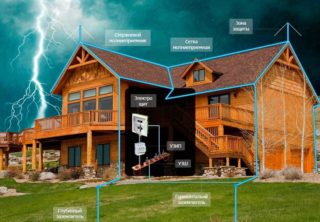
If the grounding equipment is out of order or does not correspond to the technical characteristics or the power of the electrical equipment, this can lead to equipment breakdown or injury to a person or animal by a high-voltage discharge.
Lightning is an electrical discharge with high power ratings. The voltage of the electric field of a natural phenomenon reaches several million volts, and the current strength reaches several thousand amperes. Therefore, when lightning strikes a personal plot or directly into a structure, frightening consequences occur - household appliances will fail without the possibility of restoration, the electricity network will have to be replaced, and lightning, even with a small discharge, is a danger to human lives.
Lightning protection is specially designed equipment that is used to prevent such consequences. Thunderstorm protection of electrical equipment in a private house and other structures is provided by changing the trajectory of the electric discharge directed into the ground.
Grounding devices are designed to prevent accidents caused by electric shock due to phase closure on the housing of household appliances or any other electrical appliance, heating and water pipes, as well as other conductive materials. The principle of operation is based on the connection of all potentially hazardous electrical devices to earth using conductors.
Lightning rod components
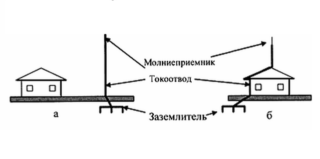
Lightning protection is a system of indoor and outdoor devices that prevent lightning from entering a building. Protection against damage is carried out in three stages, each of which is realized due to the correct operation of a separate component. The scheme of grounding, neutralization and lightning protection includes:
- Lightning rod. The main task of this part is to catch a powerful electric charge that came from outside. It is required to install this working unit at the highest point of the structure using wooden supports. Visually it looks like a rod made of metal. The length ranges from 20 cm to 1.5 m, the diameter is no more than 12 mm, and the minimum cross-sectional area is 100 mm2.
- A down conductor is a wire-like conductor that is connected to an air terminal. Its main task is to conduct a discharge through itself to the ground electrode. A characteristic feature of the part is its exceptional resistance to heavy loads (more than 200,000 Amperes), which it transfers without deformation, modifications and other destructive processes. Installation involves welding it on one side to the lightning rod, and on the other side to the ground electrode. An important condition is that the fastening is reliable and durable, otherwise the lightning does not go into the ground, but inflicts a crushing blow on a residential building or other structure.
- The last integral part of the design is the ground electrode system. Visually it looks like an ordinary sheet made of metal. It must be buried in the ground, the optimal depth in the soil is 1-2 meters. The part is designed to dissipate the current in the soil.
The structure of the lightning protection system is not characterized by complicated technical issues. Everything is quite simple, but effective at the same time.
Types and types of protection of grounding, lightning rod
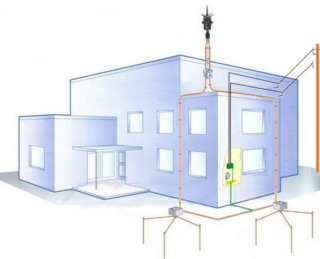
The lightning protection system redirects lightning from the building to the ground. With the help of conductors, a dangerous discharge moves away from hazardous areas, reliably protecting housing, household appliances and electrical appliances, as well as the health and lives of all household members. To protect yourself 100%, you need to install the structure as far as possible from home, as well as communication systems. A great danger is a collision of a lightning discharge with a gas pipeline.
There are two types of lightning protection:
- external (external);
- internal.
An external lightning protection system is also called passive. Multiple worker nodes have failed and are tasked with redirecting a direct lightning strike. Lightning protection consists of a lightning rod, a down conductor and a grounding device.
The main task of internal protection is to equalize the potential on metal cases, devices in the room. This happens with the help of surge arresters and SPDs.
To ensure complete safety, you need to take care of the construction of external protection and the organization of the internal one. The cost of two types and their installation is a costly business, but this will allow in the future to save considerable sums for the restoration of burnt-out devices, etc.
Active system
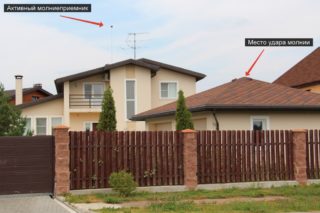
To calculate active lightning protection, it is required to take an increase in the protection radius as a basis. The system is a special equipment that ionizes the air near itself, attracting a lightning discharge to a specific place.
The advantage of this protection is that it is installed once and requires no maintenance. The diameter of the working area reaches 80 meters. They are mounted one meter higher than the highest point of the structure.
Lightning rod structures
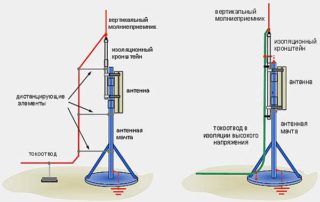
The upper part of the lightning protection system, installed at the highest point of the building, is divided into several types:
- Rod receiver. Its peculiarity lies in the pointed end. It is at him that lightning strikes during a thunderstorm. Produced, as a rule, from a copper pin with a diameter of 15 mm. The location must be high enough, but not excessive, otherwise the device will independently attract all electrical discharges to itself. Has an attractive appearance.
- The advantage of the cable version is that it creates a large protective radius, unlike analogs. Rope structures are used in power transmission line devices. They use not metal pins, but a cable that is connected to other working parts with bolts.
- There are also mesh structures. Their peculiarity lies in the fact that a mesh made of metal is installed on the roof of the house.
There is a regularity - the longer the length of the metal pin (rod, cable receiver), the larger the area of the protected area.
The protective system must be installed directly on the building, at the highest point of the structure. The grounding segment is dug into the ground to dissipate the discharge, it is connected to the air terminal using a conductor. It is not necessary to check and inspect lightning protection devices; it is enough to install the system once.








